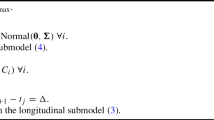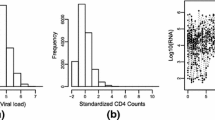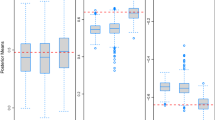Abstract
Joint models have received increasing attention during recent years with extensions into various directions; numerous hazard functions, different association structures, linear and non-linear longitudinal trajectories amongst others. Here, we present a partially linear joint model with a Bayesian smoothing spline component to capture non-linear longitudinal trajectories where the longitudinal data can assume non-Gaussian distributions. Our approach is stable with regards to the knot set as opposed to most well-known spline models. We implement this method using the R-INLA package and show that most joint models with shared Gaussian random effects are part of the class of latent Gaussian models (LGMs). We present an illustrative example to show the use of the stable partially linear joint model and an application to real data using a skew-normal partially linear joint model. This paves the way for efficient implementation of joint models with various complex model components using the same methodology and computational platform.





Similar content being viewed by others
References
Andrinopoulou, E. R. and Rizopoulos, D. (2016). Bayesian shrinkage approach for a joint model of longitudinal and survival outcomes assuming different association structures. Statistics in Medicine 35, 26, 4813–4823.
Andrinopoulou, E. R., Eilers, P. H., Takkenberg, J. J. and Rizopoulos, D. (2018). Improved dynamic predictions from joint models of longitudinal and survival data with time-varying effects using p-splines. Biometrics 74, 2, 685–693.
Denison, D., Mallick, B. and Smith, A. (1998). Automatic Bayesian curve fitting. Journal of the Royal Statistical Society: Series B (Statistical Methodology)60, 2, 333–350.
Friedman, J. H. (1991). Multivariate adaptive regression splines. The Annals of Statistics, 1–67.
Guo, X. and Carlin, B. P. (2004). Separate and joint modeling of longitudinal and event time data using standard computer packages. The American Statistician 58, 1, 16–24.
He, X., Shen, L. and Shen, Z. (2001). A data-adaptive knot selection scheme for fitting splines. IEEE Signal Processing Letters 8, 5, 137–139.
Henderson, R., Diggle, P. and Dobson, A. (2000). Joint modelling of longitudinal measurements and event time data. Biostatistics 1, 4, 465–480.
Hu, C. and Sale, M. E. (2003). A joint model for nonlinear longitudinal data with informative dropout. Journal of Pharmacokinetics and Pharmacodynamics30, 1, 83–103.
Huang, Y., Lu, X., Chen, J., Liang, J. and Zangmeister, M. (2018). Joint model-based clustering of nonlinear longitudinal trajectories and associated time-to-event data analysis, linked by latent class membership: with application to AIDS clinical studies. Lifetime data analysis 24, 4, 699–718.
Kim, S., Zeng, D. and Taylor, J. M. (2017). Joint partially linear model for longitudinal data with informative drop-outs. Biometrics 73, 1, 72–82.
Köhler, M., Umlauf, N., Beyerlein, A., Winkler, C., Ziegler, A. G. and Greven, S. (2017). Flexible Bayesian additive joint models with an application to type 1 diabetes research. Biometrical Journal 59, 6, 1144–1165.
Leitenstorfer, F. and Tutz, G. (2007). Knot selection by boosting techniques. Computational Statistics & Data Analysis 51, 9, 4605–4621.
Lindgren, F. and Rue, H. (2008). On the second-order random walk model for irregular locations. Scandinavian Journal of Statistics 35, 4, 691–700.
Martino, S., Akerkar, R. and Rue, H. (2011). Approximate Bayesian inference for survival models. Scandinavian Journal of Statistics 38, 3, 514–528.
Martins, T. G. and Rue, H. (2014). Extending integrated nested Laplace approximation to a class of near-Gaussian latent models. Scandinavian Journal of Statistics 41, 4, 893–912.
Proust-Lima, C. and Taylor, J. M. (2009). Development and validation of a dynamic prognostic tool for prostate cancer recurrence using repeated measures of posttreatment PSA: a joint modeling approach. Biostatistics 10, 3, 535–549.
Rizopoulos, D. (2016). The r package jmbayes for fitting joint models for longitudinal and time-to-event data using mcmc. Journal of Statistical Software 72, 1, 1–46.
Rizopoulos, D. and Ghosh, P. (2011). A Bayesian semiparametric multivariate joint model for multiple longitudinal outcomes and a time-to-event. Statistics in Medicine 30, 12, 1366–1380.
Rue, H., Martino, S. and Chopin, N. (2009). Approximate Bayesian inference for latent Gaussian models by using integrated nested laplace approximations. Journal of the Royal Statistical Society: Series B (Statistical Methodology)71, 2, 319–392.
Serrat, C., Rué, M., Armero, C., Piulachs, X., Perpiñán, H., Forte, A., Páez, Á. and Gómez, G. (2015). Frequentist and Bayesian approaches for a joint model for prostate cancer risk and longitudinal prostate-specific antigen data. Journal of Applied Statistics 42, 6, 1223–1239.
Simpson, D., Lindgren, F. and Rue, H. (2012). Think continuous: Markovian Gaussian models in spatial statistics. Spatial Statistics 1, 16–29.
Simpson, D., Rue, H., Riebler, A., Martins, T. G., Sørbye, S.H. et al. (2017). Penalising model component complexity: A principled, practical approach to constructing priors. Statistical Science 32, 1, 1–28.
Sørbye, S.H. and Rue, H. (2014). Scaling intrinsic gaussian markov random field priors in spatial modelling. Spatial Statistics 8, 39–51.
Spiriti, S., Eubank, R., Smith, P. W. and Young, D. (2013). Knot selection for least-squares and penalized splines. Journal of Statistical Computation and Simulation 83, 6, 1020–1036.
Tsiatis, A. A. and Davidian, M. (2004). Joint modeling of longitudinal and time-to-event data: an overview. Sinica, 809–834.
van Dijkhuizen, E. P., De Iorio, M., Wedderburn, L. R. and Deakin, C. T. (2018). Clinical signs and symptoms in a joint model of four disease activity parameters in juvenile dermatomyositis: a prospective, longitudinal, multicenter cohort study. Arthritis Research & Therapy 20, 1, 180.
Van Niekerk, J. and Rue, H. (2020). Skewed probit regression - identifiability, contraction and reformulation. RevStat (submitted).
Wulfsohn, M. S. and Tsiatis, A. A. (1997). A joint model for survival and longitudinal data measured with error. Biometrics, 330–339.
Yue, Y. R., Simpson, D., Lindgren, F., Rue, H. et al. (2014). Bayesian adaptive smoothing splines using stochastic differential equations. Bayesian Analysis 9, 2, 397–424.
Zagars, G. K., Pollack, A., Kavadi, V. S. and von Eschenbach, A. C. (1995). Prostate-specific antigen and radiation therapy for clinically localized prostate cancer. International Journal of Radiation Oncology, Biology, Physics 32, 2, 293–306.
Zhou, S. and Shen, X. (2001). Spatially adaptive regression splines and accurate knot selection schemes. Journal of the American Statistical Association 96, 453, 247–259.
Author information
Authors and Affiliations
Corresponding author
Additional information
Publisher’s Note
Springer Nature remains neutral with regard to jurisdictional claims in published maps and institutional affiliations.
Appendix
Appendix
1.1 Computational considerations for joint models in using INLA
The likelihood of a joint model b asically consists of two types of likelihoods and this can be facilitated in the INLA framework. It is essential to construct the response matrix and the covariate matrices correctly for the estimation procedure. For the purpose of this paper, we will present only the case where the joint model consists of longitudinal and survival submodels. This can be extended to include more marginal submodels in the case of multiple endpoint modeling.
Within the context of this paper, consider the following structured predictors of the longitudinal and survival submodels, respectively:
Consider the case where the data consists of Ni,i = 1,...,N observations for each of the N individuals, so that in total there are NL longitudinal observations and correspondingly NS = N event times and censoring indicators (si,ci),i = 1,...,N. The data is then composed as a list in which each variable consists of NL + NS elements. To achieve this, we include zeros for fixed effects if the covariate is not included in that specific submodel and NA’s for the random effects. In the case of Eq. A.1, the new response is defined as a list of the yijk and (si,ci). The fixed effect covariates are constructed as \((\boldsymbol {X},\boldsymbol {0}_{1,...,N_{S}})\) and \((\boldsymbol {0}_{1,...,N_{L}},\boldsymbol {Z})\) while the random effects are constructed as \((\boldsymbol {\alpha },\boldsymbol {NA}_{1,...,N_{S}})\).
The main contribution in this area is the estimation of α. Most of the commonly used approaches to estimate the non-linear trend invloves the use of knots. This method was also used in Kim et al. (2017). In this paper we propose the use of a time-continuous spline model manifested as a second-order random walk presented in Section 4.
1.2 Example: Simulated joint model
In this example we simulated data from the following scenario:
where \(v_{i}\sim N(0,{\sigma ^{2}_{v}})\) are the subject-specific random effects that are shared in this joint model, Age is a linear covariate and f(t) is a non-linear mean longitudinal trajectory. The aim of this example is to illustrate the practical method to fit a joint model in R-INLA and compare the estimated trajectories from R-INLA and jplm with the true underlying mean trajectory f(t).
We investigated two scenario’s with different forms of f(t). For each scenario we present a graphical presentation of the estimated trajectories based on different simulated samples from the same underlying process.
-
In Fig. 6 four samples and their results from f(t) = t2 are illustrated.
-
In Fig. 7 two samples and their results from f(t) = t− 0.25 are illustrated.
It is clear from Figs. 6 and 7 that the random walk two model captures the true underlying longitudinal trajectory in the joint model much better than the spline approach proposed and embedded in the jplm function.
The R code is available at http://www.r-inla.org/examples/case-studies/van-niekerk-bakka-and-rue-2019.
1.3 Computational framework information
The R code used to obtain the results as presented in Sections 6 and 7 is available at http://www.r-inla.org/examples/case-studies/van-niekerk-bakka-and-rue-2019http://www.r-inla.org/examples/case-studies/van-niekerk-bakka-and-rue-2019.
The computational time needed was for an Apple Macbook Pro i5 3.1GHz with 16GB 2133 MHz LPDDR3.
Rights and permissions
About this article
Cite this article
van Niekerk, J., Bakka, H. & Rue, H. Stable Non-Linear Generalized Bayesian Joint Models for Survival-Longitudinal Data. Sankhya A 85, 102–128 (2023). https://doi.org/10.1007/s13171-020-00233-0
Received:
Accepted:
Published:
Issue Date:
DOI: https://doi.org/10.1007/s13171-020-00233-0






